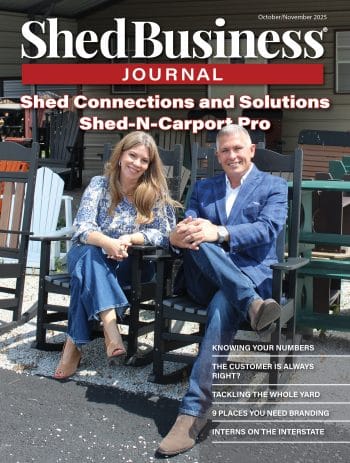
Mark Zook has learned to pivot quickly during times of rising costs, whether they be in materials, wages, insurance, or a host of other items that could impact his profit margin.
He credits his father Gideon’s years of shed-building experience for Stoltzfus Structures’ ability to recognize and prepare for potential threats to their bottom line.
“We stay in front of the problem by buying heavily when the prices are good,” says Zook, partner and CEO of the Atglen, Pennsylvania-based shed builder. “We don’t run lean. That gives us time to pivot if prices increase, since we usually have enough lumber to work through before we need to start buying new product.”
Their business model was put to the test during the COVID pandemic when both the demand for sheds and lumber prices skyrocketed at the same time. While many of their competitors weren’t paying attention to their bottom line during the flurry of activity, and ended up losing money, Stoltzfus Structures was able to keep costs down.
“Our mindset is to keep doing what we’re doing, and when times change, we pivot fast,” he adds. “We don’t spend a lot of time worrying about price increases, to be honest. It’s in the back of our minds, of course, but if does happen we can react quickly.”
Like Stoltzfus, most shed companies share a common goal—planning for and reacting to cost fluctuations in a manner that builds predictability into their profit margins.
ANNUAL PERSPECTIVE
Wesley Weaver, co-owner at Golden State Buildings in Sanger, California, says he’s careful not to be too reactive during periods of short-term increases in cost. Golden State establishes its budget at the beginning of every year and avoids any knee-jerk reactions to temporary price bumps.
“That might mean we take a short-term hit to our profit margin, but we try to maintain an annual perspective,” Weaver says. “In the end, it usually won’t cause any long-term damage to our profitability.”
They also provide financial incentives to their procurement manager—similar to a salesperson’s commission—for finding better deals.
“A consultant we hired suggested that we do that, and it has worked out great,” Weaver says. “For example, a supplier recently had some odd-sized nails that were a quarter of the cost, and he bought a whole pallet. He wouldn’t have found that if he hadn’t been looking.”
They’ve even trucked lumber from across the country—from North Carolina to California—to get a better price.
“Even with transportation, it was a better deal,” he adds. “We could have gotten it locally, but shipping would have been more expensive.”
Golden State’s approach to procurement has been undeniably successful.
“Looking at material or other prices once a year just isn’t going to cut it,” he adds. “You must continuously monitor prices and look for better deals.
“The material and the lumber are the biggest single items in terms of overhead, and if you can shave that down just a little bit that makes a huge difference on a grand scale. The same goes for labor, which is our second biggest cost. We look for efficiencies there as well.”
BUILDING A CUSHION
David Riley, customer sales and support at Countryside Sheds LLC in Island City, Oregon, says his company builds a certain amount of “cushion” into its prices to enable them to handle most short-term cost fluctuations.
In periods of significant instability, such as with lumber during the pandemic, they’ll include a disclaimer in their proposals stating that material prices are subject to change.
They also consistently maintain a materials spreadsheet that lists all components and prices for each style of shed, including 2 by 4s, hardware, plywood, etc., “and we keep an eye on the market to see if there are any wild swings or if it’s staying within our cushion for that material.”
As an additional hedge against inflation, they’ll buy materials in bulk, then store siding and surplus lumber in a covered facility on site. And while they like to buy locally, when possible, they aren’t necessarily tied to certain vendors.
“We don’t just blindly call them up and place an order,” Riley says. “We’ll compare it with a couple of other mill yards, or even big box stores like Home Depot, then go back to see if they can match or beat the price. Sometimes they can and sometimes they can’t.”
Recently, Countryside ordered a pallet of roofing fasteners substantially cheaper than the local vendor could provide.
“It came with a flat shipping fee based upon the size of the shipment and we ran calculations on the shipment size to get the best rate,” he adds. “It saved us hundreds of dollars.”
They also found a new windows vendor who offered a faster turnaround time—from three weeks to two—as well as offered direct shipping from the factory to their facility for no charge.
Fortunately, Countryside’s costs have been relatively stable over the last year. Most of his lumber—their most significant expense by far—comes from a mill that’s only a short drive away.
“That makes it very convenient for us,” he adds. “They’ll often call us about specials where we’ll have the opportunity to buy at a special rate.”
PROFITABILITY STRUGGLES
To keep abreast of projected cost fluctuations, Zook communicates frequently with his closest competitors, as many of them are good friends.
“We stay in touch to talk about what we’re all experiencing price-wise,” he adds. “I believe in staying in touch with others in order to check the pulse of the market.”
Zook says lumber prices have stabilized significantly since the tumultuous days of the pandemic, but that concern has been replaced by rising labor costs. They recently raised their prices for the first time in two years as a result.
“At the end of the day, we’re blessed with good labor but as in any market when things are busy good labor is hard to come by without paying a higher rate,” Zook says.
“When construction is booming, it’s harder to get guys. We want to pay our guys well, and it’s something that over the last four years has risen—but so has the cost of living, so we want to enable them to live a good life.”
Insurance premiums are also on the rise, but that hasn’t affected Zook as much as other shed builders. Most of his shop workers are Amish and thereby exempt from worker’s compensation insurance (which they receive through a church-sponsored insurance program).
Golden State is seeing its biggest increases in general liability and automobile insurance premiums, while material prices have been stable.
“We keep a long-term view with that as well,” Weaver says. “We’ll sometimes pay for the cost of a claim outright rather than file a claim. It affects our profitability in the short term, but in the long term, we won’t be paying higher premiums.”
Having a good working relationship with the insurance agent is critical throughout the process. “They’ll go to bat for you,” he adds. “That can make a huge difference in the bottom line.”




